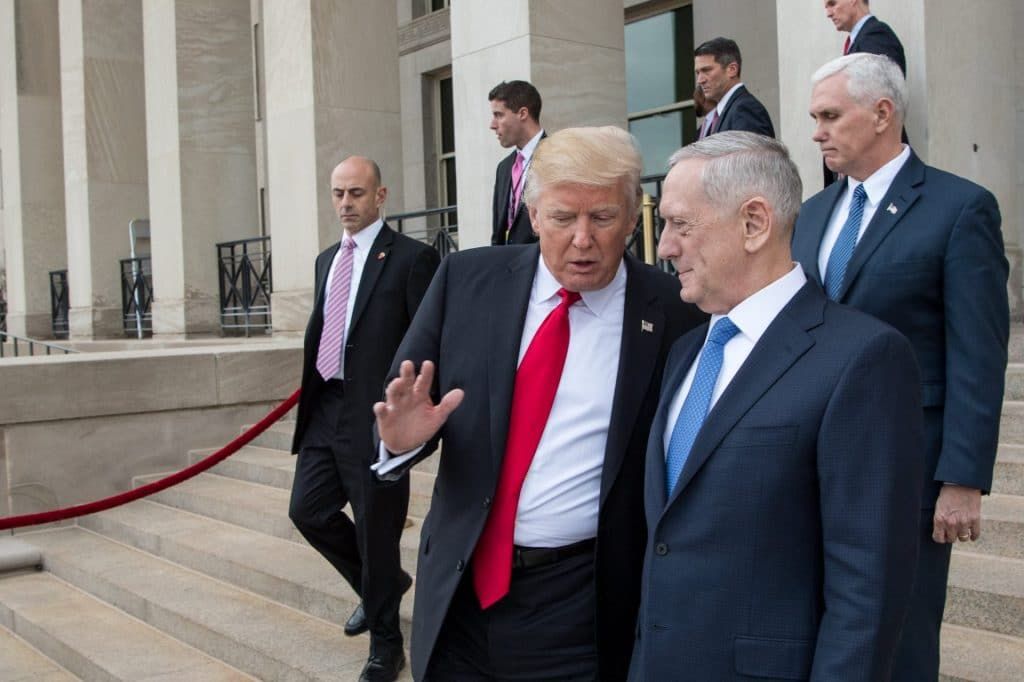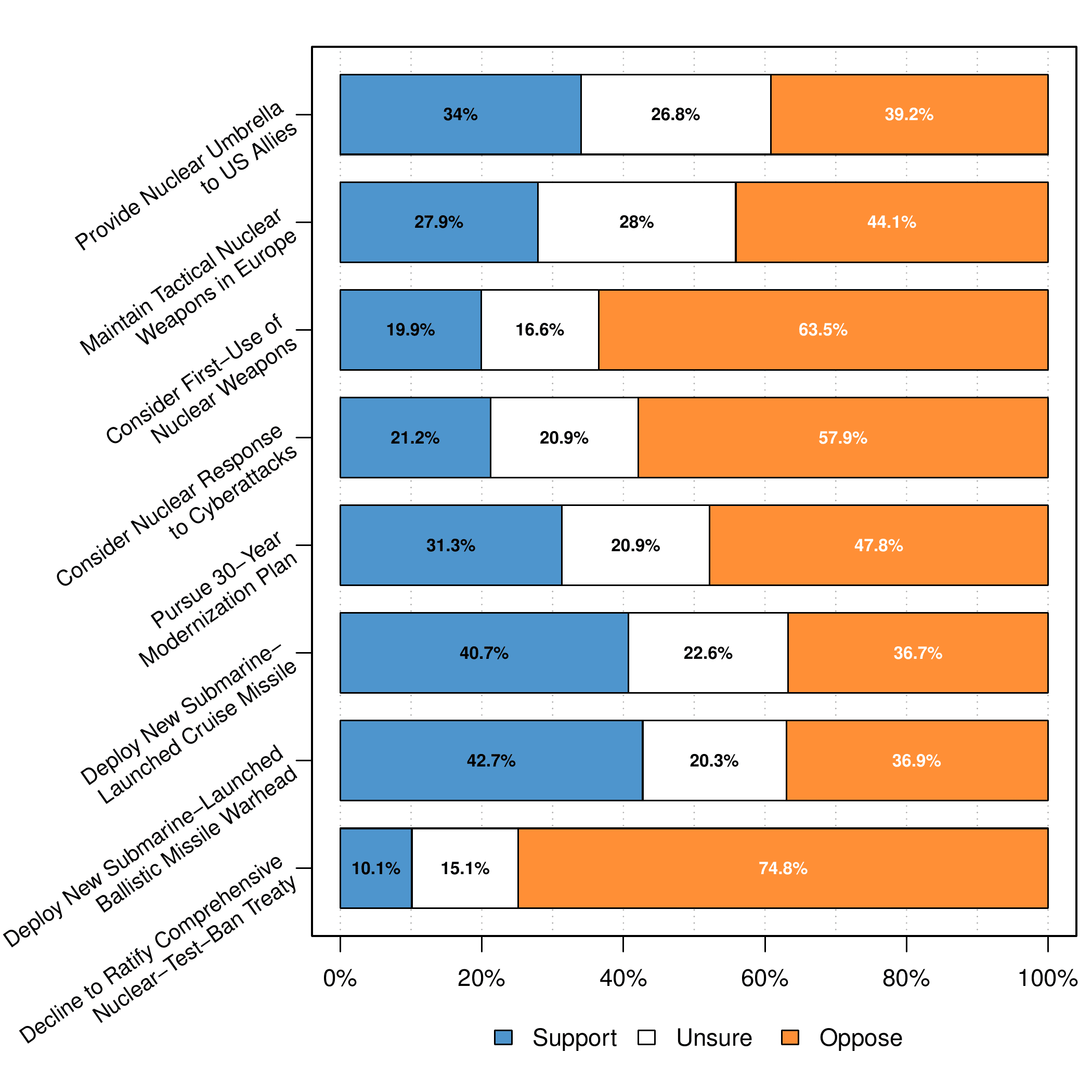Poll: What the American public likes and hates about Trump’s nuclear policies
By Jonathon Baron, Stephen Herzog | April 27, 2020
 US President Donald Trump with his first Secretary of Defense, James Mattis, in 2017. Mattis oversaw the 2018 Nuclear Posture Review. Photo credit: US Defense Department via Flickr.
US President Donald Trump with his first Secretary of Defense, James Mattis, in 2017. Mattis oversaw the 2018 Nuclear Posture Review. Photo credit: US Defense Department via Flickr.
It is difficult to overstate the importance of nuclear policy in determining a US presidential candidate’s fitness to be commander-in-chief. Such priorities are evident in the Bulletin’s recently published special issue dedicated to discussing nuclear weapons policy ahead of the 2020 election. Nuclear issues played a prominent role in the 2016 election, but despite some anomalies, they have hardly factored into the 2020 campaign. This is almost certain to change even as priority is given to the COVID-19 pandemic response. Nevertheless, very few recent polls (with one notable exception) have attempted to identify preferences among the US population for President Donald Trump’s nuclear policies.
To fill this gap, we worked with the firm YouGov in late 2018 after the release of the Trump administration’s Nuclear Posture Review to conduct a nationally representative survey of 1,000 Americans. Previous surveys have illuminated US public attitudes on nuclear energy, extending the New START treaty, and even hypothetical nuclear retaliatory scenarios. It isn’t clear, however, how Americans view the core elements of the Trump administration’s nuclear policy: its Nuclear Posture Review and its overall strategies toward Iran and North Korea. We report our study results publicly for the first time here, offering insights for policymakers and presidential candidates as they weigh their positions on nuclear issues.
Nuclear Posture Review. The study highlights how the US public as a whole and various demographic groups view Trump’s positions on nuclear weapons. To begin, we asked respondents to indicate whether they supported, opposed, or were unsure about key parts of the 2018 Nuclear Posture Review.
Of course, many elements of the Trump administration’s nuclear posture are continuations of longstanding US policy that have been preserved by Republican and Democratic presidents alike. Our survey questions did not indicate the current US administration’s policy on different parts of the Nuclear Posture Review. So the results convey the respondents’ natural preferences for the policies themselves, not for the current occupant of the White House. Such data should prove useful to politicians staking out campaign stances on nuclear weapons that would have broad public appeal.
Our findings reveal that Americans overall express fairly low support for the administration’s nuclear weapons policies, though indecision also runs high among the public. Further, the table of group preferences indicates—with a few surprising exceptions—that males, Republicans, and older Americans are the most likely groups to back President Trump on nuclear issues. Even so, support is relatively modest among Trump’s base, and several elements of the Nuclear Posture Review do not receive majority or even plurality support from Republicans.
Figure 1. Public Opinion on the 2018 Nuclear Posture Review

Figure 2. Group Support Levels for 2018 Nuclear Posture Review
Deterrence and nuclear retaliation. The Nuclear Posture Review continues the policy of extending a nuclear umbrella “to over thirty allies and partners” with approximately 1,750 deployed US warheads. Around 150 of these weapons are B61 tactical nuclear gravity bombs deployed in Europe. These policies of extended deterrence continue, despite Trump questioning the logic of the nuclear umbrella on many occasions. Similarly, our results indicate a skeptical public.
Only 34 percent of Americans support the longstanding policy of providing the nuclear umbrella in principle, and that number drops to 27.9 percent for nuclear deployments in Europe. It is no wonder that some experts have speculated that countries like Germany, Japan, and South Korea may soon consider building the bomb. Yet, even with Trump’s rhetoric against these assurances, men and Republicans remain the most supportive of the nuclear umbrella and forward-deployed B61 nuclear bombs. Women, Democrats, and Independents respond less favorably. Additionally, Americans who came of age during the Cold War are more favorable toward these policies than their Millennial and Generation Z counterparts.
We also estimate that fewer than 20 percent of Americans support possible US first use of nuclear weapons. By contrast, disapproval stands at 63.5 percent. Somewhat unpredictably, we found that only 13.2 percent of Republicans approve of the US using nuclear weapons first, compared to 22.2 percent of Democrats and 22.7 percent of Independents. And despite being the age bracket most supportive of extended deterrence, respondents age 55 and older are least likely to back a first-use declaratory policy. The public is also broadly unsupportive of using nuclear weapons in response to cyberattacks. Greater Republican support—representing a minority of Republicans nonetheless—for this policy than for nuclear first use more generally is slightly puzzling given its inconsistency.
Still, our counterintuitive findings regarding Republicans and Americans age 55 and older raise an interesting question: Why might groups that tend to support extended deterrence strongly oppose first use of nuclear weapons? We speculate that two factors may account for this puzzle, although further investigation is warranted to definitively answer the question. First, older voters are more likely to be Republicans than Democrats, so these results may be related. Research shows that Americans who were alive during the peaks of the US–Soviet arms race are less likely to support nuclear use than younger generations. Second, it is possible that many individuals who have faith in the credibility and mechanics of deterrence simply find a first-strike declaratory policy unnecessary.
Regardless, a majority of every demographic group of Americans—whether by gender, political party, age, race, education, income, or region of residence—oppose a first-use doctrine. Public opinion may accordingly present opportunities for presidential candidates to favor a policy of no first use of nuclear weapons.
Modernization, development, and testing. On the whole, the public doesn’t support the Nuclear Posture Review’s continuation of Obama administration efforts to modernize the nuclear stockpile and complex. The Congressional Budget Office notes this 30-year plan will cost $1.2 trillion by 2046. This may amount to $1.7 trillion after adjusting for inflation, or up to 6 percent of defense spending. Public opposition stands at 47.8 percent, with 31.3 percent approving and 20.9 percent undecided. But there are clear divisions along partisan and age lines. A slim majority of Republicans endorse the modernization strategy while a stronger majority of Democrats object. Since just 17.6 percent of Americans ages 18–34 approve of such spending on nuclear weapons, it remains to be seen whether the modernization plan remains politically viable in coming decades.
However, even if the public is lukewarm about nuclear spending in principle, it is unclear to what extent voters understand the modernization program. Its projects include wide-ranging warhead and missile life extension programs, command and control upgrades, and new production sites like the Uranium Processing Facility at the Y-12 National Security Complex. The program also calls for the development of several new strategic systems such as the B-21 Raider strategic bomber, the Columbia-class ballistic missile submarine, the Ground-Based Strategic Deterrent intercontinental ballistic missile, and the Long-Range Stand-Off air-launched cruise missile.
We surveyed Americans about two specific efforts that have received considerable media coverage: the now-deployed W76-2 low-yield warhead for submarine-launched ballistic missiles and the proposed new submarine-launched nuclear cruise missile. If negative attitudes toward modernization were informed by components of the program, we would expect the public to oppose both efforts. Instead, a plurality of the public favors each—with stark gender, age, and political party divisions. A majority of men, a plurality of older Americans, and nearly two-thirds of Republicans approve. Women, young people, and Democrats are far less enthusiastic. Regardless, greater support for these systems versus modernization in general suggests the public may be relatively persuadable about other efforts to strengthen the US deterrent.
Last, we asked participants about the Nuclear Posture Review statement that “the United States will not seek ratification of the Comprehensive Nuclear Test Ban Treaty.” A 2012 National Academy of Sciences study effectively addressed concerns about potential treaty verification and about the efficacy of the Stockpile Stewardship Program for maintaining a safe, secure, and reliable arsenal without nuclear explosive tests. And the administration’s policy diverges from more than six decades of public opinion polling, including our own previous work showing 65 percent of Americans want ratification. Our findings were even stronger this time, indicating that only 10.1 percent of Americans agree with the Trump administration’s policy of not seeking treaty ratification. On the other hand, 74.8 percent prefer US ratification and 15.1 percent remain undecided. Stunningly, a mere 11.4 percent of Republicans, 12.5 percent of Independents, and 7.5 percent of Democrats agree with President Trump on the issue. The door of public opinion appears to be wide open for presidential candidates to pledge their support for the Comprehensive Nuclear Test Ban Treaty.
Iran and North Korea. Aside from the ongoing COVID-19 crisis, few foreign policy issues throughout Trump’s term have commanded public attention like his nuclear diplomacy with Iran and North Korea. The president’s approaches toward these countries could hardly differ more. It is imperative for candidates to understand how the public views these divergent paths. Although there have been new developments in American relations with Iran and North Korea, the overall trajectory of US policy hasn’t changed since we conducted our survey. The results therefore provide a useful snapshot of public views.
The Trump administration has overseen a dramatic worsening of US–Iran relations. Trump withdrew US participation from the Iran nuclear deal, or Joint Comprehensive Plan of Action, in May 2018. He has since waged a campaign of “maximum pressure” consisting of harsh sanctions and military threats. These actions led to mutual escalations including the killing in January 2020 of Iranian Quds Force commander General Qasem Soleimani by a US MQ-9 Reaper drone and retaliatory ballistic missile strikes against US air bases in Iraq. Both sides have since deescalated, and polling indicates the US public has no interest in war with Iran. Unfortunately, diplomacy still appears exceptionally unlikely in the future due to continuing high tensions.
The survey asked about support or opposition for Trump’s position of withdrawing from the deal and reimposing sanctions on Iran. Opinion is predictably divided, with 54.1 percent favoring the withdrawal and 45.9 percent dissenting. Unsurprisingly, partisanship appears to be the primary driver of individual support for the agreement. A strong majority of Republicans (88.6 percent) favor remaining outside the deal with just 11.4 percent in opposition. On the other side of the aisle, only 23.4 percent of Democrats approve of President Trump’s Iran policy and 76.6 percent would prefer to see the United States return to the deal. Among Independents, 53.5 percent back the withdrawal and 46.5 percent do not. While many of the survey results point to surprising public consensus on nuclear issues, approaches to Iran remain divisive.
US–North Korea tensions have also been concerningly high at several points during the Trump administration. North Korea accelerated its nuclear and ballistic missile testing, and its Supreme Leader Kim Jong-un and President Trump even famously exchanged nuclear threats, with the president issuing some via Twitter. However, Kim announced a unilateral moratorium on tests in April 2018, and the two subsequently held face-to-face nuclear negotiations in Singapore and Hanoi, Vietnam. But following the failure to quickly achieve a deal, at the beginning of 2020, Kim declared that North Korea was no longer bound by the testing moratorium. As of March 30, North Korea’s Foreign Ministry stated that the country was no longer interested in dialogue with the United States. Denuclearization now seems as far away as ever.
We asked respondents to rate their satisfaction with the results Trump achieved at the Singapore Summit. This is an important matter because the administration has touted Singapore as an overwhelming success in North Korea’s journey toward denuclearization. The public is somewhat evenly divided: 30.1 percent are satisfied, 33.1 percent are dissatisfied, and 36.8 percent are undecided. Predictably, support for Trump’s diplomacy split along political party lines. Yet, average public attitudes toward ongoing diplomacy more closely approximate indecision than political polarization. Perhaps the public has come to the same conclusion that most policymakers seem to have reached. When dealing with North Korea, there are few ideal options, but none less so than war against a country with demonstrated nuclear weapons capabilities.
Toward the election. Voters need to understand candidates’ nuclear policy positions before heading to the polls. But public preferences must also be part of the equation. While the vast majority of Americans are simply not nuclear policy or technology experts, nuclear issues nonetheless evoke strong emotions. Our study demonstrates that, while indecision is widespread, the public has several clear preferences on topics related to nuclear weapons. Politicians would be wise to consider their broad contours when formulating campaign platforms.
What are the US public’s preferences on nuclear weapons? In the age of “America First,” the public appears increasingly skeptical of taking on risks even on behalf of Washington’s closest allies. It may be time for leaders to articulate why alliances and the nuclear umbrella are important, or to begin reassessing policies like forward-deployed tactical nuclear weapons. The public also opposes the first use of nuclear weapons, even in response to a cyberattack. These findings suggest a need to revisit declaratory policy and the possibility of making a no-first-use pledge. Likewise, Americans emphatically support ratifying the Comprehensive Nuclear Test Ban Treaty and slamming the door on US nuclear explosive tests. Overall, the public dislikes spending significant taxpayer dollars on nuclear weapons but appreciates the value of specific systems. And while nuclear diplomacy with Iran remains in bitter partisan gridlock, many Americans appear to be taking a wait-and-see approach to Trump’s talks with North Korea.
Whether presidential candidates heed Americans’ attitudes is up to them and their advisors. However, our study suggests that the US public would be receptive to politicians staking clear positions, even if they involve bold changes to longstanding nuclear doctrine. And if politicians and political parties dislike these public attitudes, then they ought to be held accountable to justify their alternatives.
Data and results from the study are available from the authors upon request.
Together, we make the world safer.
The Bulletin elevates expert voices above the noise. But as an independent nonprofit organization, our operations depend on the support of readers like you. Help us continue to deliver quality journalism that holds leaders accountable. Your support of our work at any level is important. In return, we promise our coverage will be understandable, influential, vigilant, solution-oriented, and fair-minded. Together we can make a difference.
Keywords: US nuclear arsenal, US nuclear policy, United States, nuclear weapons, polls
Topics: Analysis, Nuclear Weapons

















If the Commander in Chief is not fit for command of the world’s largest arsenal of nuclear weapons, not only should the C-in-C be replaced but great consideration must be given to the overall usefulness of nuclear weapons in the 21st Century. Nuclear weapons cannot fight pandemics, nor climate change. Neither can the fight poverty and disease in poorer countries. The threat seems to have moved on from nuclear arsenals to cyberwarfare and/or bioweapons. Had Covid-19 been a bio weapon all your nuclear weapons would not have stopped it.